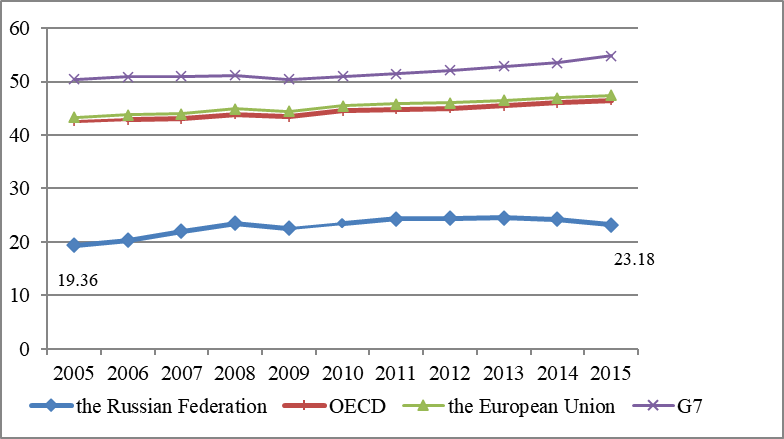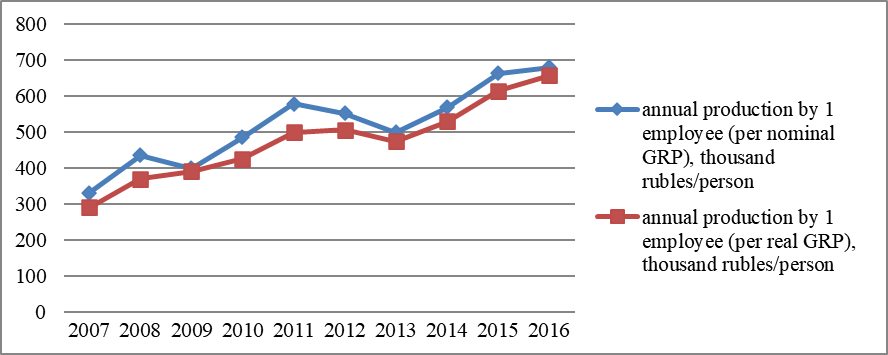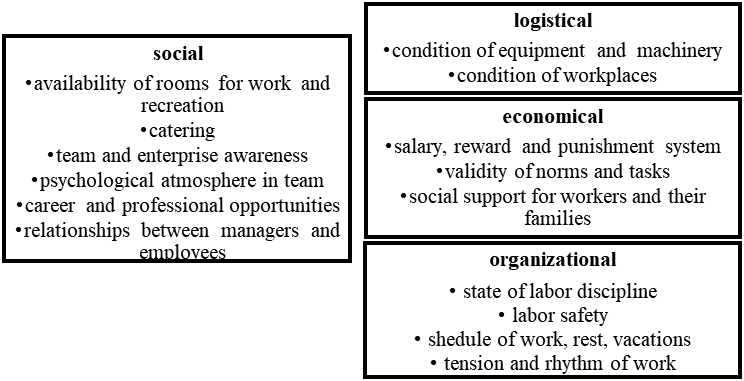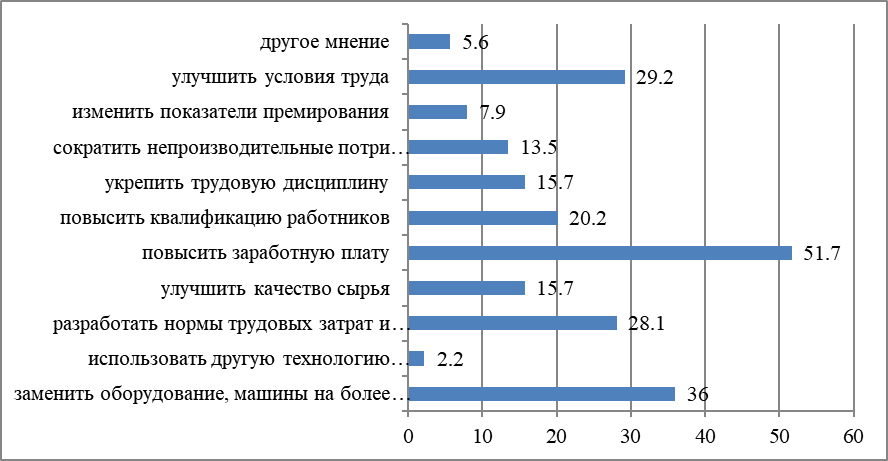Abstract
The article is devoted to the analysis of conditions and factors of labor productivity growth. As an example, agro-industrial enterprises of Kemerovo region were taken. Research strategy is directed to the analysis of qualitative and quantitative information on the condition of an object, the use of such empiric methods as statistic data analyses, unstructured interviews with executives, and employee questionnaires. In 2017, the Federal Program was adopted, in order to increase labor productivity and contribute to employment. To implement the Program, representatives of enterprises of all fields and all business entities must participate actively. The results of an expert interview demonstrate that executives are very concerned with the problem of low labor productivity in the whole country, in Kemerovo region, in their own enterprises, and can see the ways of its solution, but they are not included properly in corresponding managing aspects. On the average, in the agro-industrial sector the labor productivity increase goes on faster than in other industrial fields of our country, but in terms of value it is low. When workers of a Kuzbass enterprise containing of two agricultural consumer cooperatives for the production of dairy products were questioned, it was revealed that there were the following problems: bad condition of equipment and mechanisms, uncomfortable work and rest schedule, unsatisfactory working tension and rhythm, ineffective system of work stimulation, insufficient social support for workers, and others. So, the factors of labor productivity growth lay in the economic and logistical areas as well as organizational and social ones.
Keywords: Agro-industrial complexeffectivenessjob satisfactionlabor productivityreserves and factors of labor productivity growth
Introduction
In recent years, in Russia we could observe certain active efforts to change economic priorities – from the extensive growth to the practice of intensive development. Since labor is one of production factors, its efficiency may manifest itself, first of all, as the growth of productivity. It is on this basis that a new model of economic development should be formed. Low labor productivity was, and is now, one of the most important problems of modern economy of the Russian Federation (RF). Figure

Back in May 2012, President of the RF issued the Decree to increase labor productivity by 1.5 times till 2018. But the task failed. The rate of growth decreased – from 3.5 % in 2012 to 0.7 in 2014, and in 2015 the labor productivity decreased by 2.2 %, in 2016 the fall continued. Besides the ordinary reasons (fixed production assets wear, outdated technologies, low labor motivation, and others), there are more specific ones (outdated management technologies, low availability of loans, large tax burden on business, deformed economic structure, etc.). In 2017, Government of the RF denoted the problem of labor productivity as a separate priority project and proposed new plans of increasing this cardinal economic indicator, adopting the State Program “Labor Productivity Increase and Employment Promotion”.
In the given circumstances, relevance and significance of theoretical and empiric research in the area of labor productivity and factors of its growth increase. Classical works on the given scientific direction are studied again (Defining and measuring productivity, 2015), modern works arouse a special interest (Tisimia, 2014; Bozo, 2017).
Questions associated with labor productivity and search for its growth reserves are topical in the whole Kemerovo region as well as relatively separate fields, including the agro-industrial complex (AIC). Unfortunately, Kemerovo region was not included as a pilot region into the State Program “Labor Productivity Increase and Employment Promotion” neither in 2017, nor in 2018. However, it does not mean that the problem of labor productivity increase in Kuzbass business entities may not be solved for some more time. In such situation, the regional science, cooperating with the real economy sector, can become a driver of developing regional labor productivity increase programs, especially considering the current scientific work (Belchik, 2013).
Problem Statement
Labor productivity is an economic category which concerns all aspects of activity organization in any area. Complexity and ambiguity of the given category stimulate scientists to study new aspects arising during economic development of various countries (Webber & Horsewell, 2009; Auzina-Emsina, 2014). The corresponding indicator is especially characterized by the fact that each participant of working process, from an ordinary worker to a top-manager, may influence it. It means that the labor productivity may and must be managed competently, though in some production teams, managers cannot understand the problem properly and do not stimulate the personnel to solve it. Nowadays, Russian enterprises lose significantly in the areas of technologies and performance, this impacting substantially the level of labor productivity (Bessonova, 2018). Besides, complex foreign political conditions, sanctions, economic fall, market competition cause managers to realize that, to ensure competitiveness, it is necessary to increase labor productivity actively and purposefully.
Research Questions
What is the dynamics of labor productivity level in the RF, Kemerovo region, and the agro-industrial complex?
What working process factors influence the level of labor productivity most of all?
What are the directions of labor productivity increase in the agro-industrial sector of Kemerovo region?
Purpose of the Study
The purpose is to study the state and factors of labor productivity growth, taking as an example the enterprises of the agro-industrial complex of Kemerovo region.
Main research task is to analyze labor productivity indicators in the whole Kemerovo region, in separate fields of economic activities (especially, agricultural ones), and one of the AIC enterprises, as well as to reveal the reserves of labor productivity growth on the basis of the analysis of opinions of agriculture experts and workers.
Research Methods
Research object is the labor productivity in the agro-industrial enterprises of Kemerovo region; research subject is factors influencing the level of labor productivity, and management impact on them. Research strategy of the authors is based on the analysis of qualitative and quantitative information on the object’s state. The authors use such cognitive methods as comparison, abstraction, analysis and synthesis. The following empiric research methods are chosen: statistic methods, non-structured interviews with executives of the enterprises of Kemerovo region, and employee questionnaires in an AIC enterprise. Please replace this text with context of your paper.
Findings
To determine the significance of labor productivity problem in Kemerovo region, and reveal its increase reserves in October-November of 2017, the series of interviews with executives of organizations of various economic activities and forms of ownership were conducted. In all, 20 interviews with heads of organizations (20%), deputy heads and heads of departments (80%), were conducted. A quarter of respondents represent state organizations, three quarters – private businesses. Among respondents there are representatives of medicine, tourism industry, insurance, police, coal mining, trade, and other fields.
All experts believe that labor productivity growth problems are and will be relevant not only for Russia, but also for Kemerovo region, and their own organizations as well. However, not every respondent is aware of modern “agenda”. Thus, the answers of the experts asked if they know anything about the development and implementation of Priority Program “Labor Productivity Increase and Employment Promotion” were distributed like this: “informed well enough” – 7 experts (35%); “heard about this” – 10 experts (50%); “don’t know” – 3 experts (15%). What experts think about the given problem also is different. Two main points of view may be distinguished:
opinions of most experts who are positive about the instruction of President to develop and implement the program as this will allow to increase the productivity in enterprises, hire workers with higher wages, stimulate the growth of economy;
opinions of those who are skeptical, because in Russia any good idea is difficult to bring into life due to “immaturity” of legislative system, corruption and national mentality. One of the experts believes that “the program is being developing by persons which are very far from the reality, regions, and problems faced by executives”. That is why the authors think that the given problem must be studied in regional organizations, together with working people.
Then the respondents named the main directions of labor productivity increase which are necessary for implementation in their organizations. Most experts mentioned such way as improvement of management system and production technologies. Some executives presume that, first of all, it is necessary to study thoroughly the situation in the organization and reveal factors influencing the level of labor production, and then develop the strategy of its growth. Among other things the following proposals were put forward: training of all staff (this recommendation was mentioned by more than a third of experts), technical equipment of the enterprise, improvement of personnel evaluation system, reduction in the number of managers, revision of norms and standards of labor, material and non-material incentives, etc. The following original ideas were proposed: learning and borrowing experience of other successful organizations, strengthening the image of the company in order to increase the social status of workers and the prestige of the organization, and some others.
Summarizing all opinions of the respondents about existing reserves of labor productivity growth in the region, we can distinguish the following:
investments in equipment upgrade (the commonest answer);
changes of management system;
development of deep processing of minerals;
innovations;
increase of employee motivation;
increase of professionalism of managers;
staff development;
working time management;
salary increase.
On the whole, the analysis of all answers showed that no organization could solve the task of increasing labor productivity systematically. Besides, some managers understand poorly the essence of the problem, do not have sufficient knowledge in the area of modern managing technologies. Frequently, executives speak with cliches and common phrases. In this context, the most topical is the idea of making regional “Centers of Competencies for Labor Productivity” proposed by the State Program.
To characterize statistically the current state of labor productivity in Kemerovo region, we used GRP per employee (Figure

In terms of value, the labor productivity dynamics shows that, on the whole, in the last decade it had a positive trend with certain periods of deviations. So, in 2013, the growth of the parameter analyzed became evident after the period of decreasing. It is much determined by the fact that in the region there is a stable pattern of reducing total employment. It is caused by negative migration balance, low birth rate, and low life expectancy. Alongside, in the structure of GRP of the region there is dependence on raw materials: the share of mining varies from 23% (in 2007) to 29.7% (in 2016).
Characterizing the agricultural labor productivity, we can say that, beginning from 2013, its rate of growth exceeds that of the whole RF. Nevertheless, the agricultural labor productivity is still low in terms of value.
In the agro-industrial complex, the growth of labor productivity is conditioned by the specific use of land, plants, animals as the means of production and labor. In agriculture, the performance is influenced by natural climate and weather conditions, various forms of ownership, private farms, etc. All these things require administrative attention in the areas of strategic planning and activities organization (Muminovic & Aljinoviv, 2015).
“State Program for Development of Agriculture and Regulation of Markets of Agricultural Production, Raw Materials and Food in 2013-2020” determines the 4 % rate of labor productivity growth per year. Besides, till 2020, 336 400 high-performance jobs in the agriculture will be made (see table
One of main fields of the agro-industrial complex of the region is dairy farming, the labor productivity in this field being the object of numerous investigations in various countries (Zdeněk & Lososová, 2014, Tisimia, 2014). Alongside with the increase of milk production in the public production sector, the development of personal part-time farms (PPF) of rural population is much stimulated. To involve private farms into the active process of agricultural production, increase rural welfare, solve long-standing social problems, agricultural consumer cooperatives (ACC) have been developing in Kemerovo region. In 2016, 17 thousand tons of milk produced by the population were purchased by cooperatives. Each PPF owner passing a kilogram of milk through the system of cooperatives is paid by the regional budget in the amount of 1 ruble and above in winter stall period, and 2 rubles and above in summer stall period. Besides, annually the regional budget allocates funds for current modernization of agricultural cooperatives. The work made allows increasing gross milk production, providing the opportunity for private farms to sell produced milk.
In two cooperatives managed by one owner (“Soglasie” and “Podvorie”) whose main activity is dairy production, the sociologic research on labor productivity problems was conducted. It should be noted that ACC “Soglasie” was made in the Promyushlennovsky district in 2006, and ACC “Poddorie” – in the Leninsk-Kusnetsky district of Kemerovo region in 2013. In their production the cooperatives use milk passed by more than 2000 partners in more than 40 inhabited localities. Many villagers improved their welfare and became interested in developing PPF, thanks to the opportunity to have a permanent market.
In January 2018, in these agricultural enterprises questionnaires were organized for their teams, in workplaces, and in the presence of the representative of the research. Of 100 workers of the company 93 were questioned; 4 profiles were rejected. Thus, the survey was based on complete statistical observation. Validity of the survey was provided by its anonymity, and relevance – by simple clear questions and variants of answers associated with the routine work of respondents. Average age of respondents was 38 years, average work experience at the given enterprise was 3.6 years, average salary was 18 821 rubles.
To evaluate labor productivity growth factors, the authors’ classification was developed (see figure

Evaluating the satisfaction of workers with various aspects of working activities, we used median values which demonstrated that maximal rating (8 points on a 10-point scale) was given to “state of labor discipline”, “condition of workplaces”, “relationships between managers and employees”, and minimal rating (5 points) – to “catering”, “condition of equipment and machinery”, “schedule of rest and work”, “tension and rhythm of work”, “labor incentive system”, “social support for workers”. It is worth noting that minimal values are in all four groups of factors. Other activities aspects were given each 6-7 points.
During the survey the respondents assessed the current state of the enterprise, the dynamics of its development, and prospects. The analysis made showed that the company could work more effectively than now, and it had reserves for this. Wherein, managers assess the working situation better than specialists, and the latter – better than ordinary workers.
To assess the reserves of labor productivity growth, ordinary workers were asked if they thought they could work with more results. The answers showed that 19% workers were sure they could, 43% were close to the given point of view (their answer was rather yes), 9 % did not see any special reserves to increase labor results, and 19 % thought they worked best. Thus, according to them, more than 60 % workers of the company could work better. Judging by the estimates of various labor conditions, the reserves which do not require significant investments may help – improvement of motivational mechanisms, time management, catering, improved working conditions, etc. Also, it is recommended to include workers into the discussion of working problems, inform them about team work, delegate authorities to them, and give them the opportunity to act independently.
During the research, the workers also answered the question “What is necessary to do in the enterprise in the first place, in order to improve the labor results of the whole team?” The given answers are shown in figure

As the given data show, the key ways of increasing performance are the increase of salary, the upgrading of equipment, the development of the norms of labor costs and the control over their execution, according to the common opinion of the workers of the cooperatives. In the given case, the measures that require significant investments are indicated, this being rather problematic. Thus, when heads of agricultural enterprises were asked the question “What problems must be solved to develop your production further?”, they chose the next offered variants (several answers were possible): “financial lack” – 69 %, “absence of new technologies, machines, other producing components” – 61 %, i.e. they indicated the financial problems in the first place. Also, 53% of managers mentioned the low labor productivity, 25% believed that the main problems were ineffective management and complicated accounting.
Conclusion
Statistic and sociologic analysis made revealed:
labor productivity growth in the Russian Federation and its regions is the primary requirement of economic rise. Judging by the recent statistic data, there is some rise, but it is insignificant and unstable. So, in 2017 the task of labor productivity increase is of high priority and requires systemic solution;
modern heads of enterprises of various fields emphasize significance and relevance of the problems associated with low labor productivity for Russia and their enterprises. However, the expert questionnaire showed that informed and complex labor productivity management was not intrinsic for most organizations;
labor productivity growth factors are numerous and different in the whole economy as well as in the agro-industrial complex. Among them, logistical, economic, organizational, and social factors may be distinguished. They were sociologically evaluated in an individual agro-industrial enterprise, and the following problems were revealed: the bad state of equipment and machinery, the uncomfortable schedule of work and rest, unsatisfied working tension and rhythm, ineffective incentive system of work, insufficient social support for workers, and some others;
key directions and mechanisms of solving problems associated with labor productivity increase (including similar problems in agricultural enterprises) are investments in equipment and production upgrades, management improvement (including labor organization and motivation), innovations, increase of managing skills, social psychological managing instruments.
Thus, the research demonstrates once more that the problem of low level of labor productivity is very relevant now for enterprises of the agro-industrial complex as well as the whole economy. To solve the problem, we must work steadily, considering the complexity of the task.
References
- Auzina-Emsina, A. (2014). Labour productivity, economic growth and global competitiveness in post-crisis period. Procedia – Social and Behavioral Sciences, 156, 317 – 321.
- Belchik, T. A. (2013). Satisfaction with various aspects of labor activity as a factor of labor productivity growth. Fundamental researches, 8(6), 1430-1433.
- Bessonova, E.V. (2018). Analysis of the dynamics of aggregate factor productivity at Russian enterprises (2009-2015). Issues of Economics, 7, 96-118.
- Bozo, N. V. (2017). Restrictions on the development of enterprises and organizations of the Russian Federation in modern conditions. Bulletin of Tomsk State University. Economy, 37, 95-112.
- Defining and measuring productivity (2015). Retrieved from OECD website: https://www.oecd.org/sdd/productivity-stats/40526851.pdf.
- Muminovic, S., & Aljinoviv, B. (2015) Productivity in dairy processing industry. Mljekarstvo, 65(4), 269-279.
- OECD (2015). OECD Compendium of Productivity Indicators 2015. Paris: OECD Publishing. Retrieved from: DOI:
- Official website of the Federal State Statistics Service, Access mode: http://www.gks.ru/ (reference date: 14 March 2018).
- Popov, A. V. (2016). Wage as a tool to stimulate labor activity. Sociological studies, 7(387), 40-47.
- Resolution of the Board of the Administration of the Kemerovo Region of October 25, 2013 No. 464 “On the approval of the state program of the Kemerovo Region” state support for the agro-industrial complex and sustainable development of rural areas in the Kemerovo Region “for 2014-2020 (as amended on December 27, 2017)”.
- Resolution of the Board of the Kemerovo Region Administration of October 25, 2013 No. 464 “On Approval of the State Program of the Kemerovo Region” State Support of the Agro-Industrial Complex and Sustainable Development of Rural Territories in the Kemerovo Region “for 2014-2020 years”.
- Tisimia, V. K. (2014). Growth of small agro-processing firms and their influence on employment creation. Morogoro, Tanzania: Sokoine University of Agriculture.
- Trubin, V., Nikolaeva, N., Palieva, M., & Khusainova, A (2017). Labor productivity in the Russian Federation. Social Bulletin, 9, 1-41. Retrieved June 23, 2017, from: https://nangs.org/analytics/analiticheskij-tsentr-pri-pravitelstve-rf-proizvoditelnost-truda-v-rossijskoj-federatsii-iyun-2017-pdf
- Webber, D. J., & Horsewell, M. (2009). Winners and Loosers Spatial Variations in Labour Productivity in England and Wales. Auckland: Auckland University of technology
- Zdeněk, R., & Lososová, J. (2014) Factors influencing the labour productivity in dairy sector in EU, Slovak University of Agriculture in Nitra. Review of Agricultural and Applied Economics, 17, 38-44. https://dx.doi.org/10.15414/raae.2014.17.02.
Copyright information

This work is licensed under a Creative Commons Attribution-NonCommercial-NoDerivatives 4.0 International License.
About this article
Publication Date
02 April 2019
Article Doi
eBook ISBN
978-1-80296-058-7
Publisher
Future Academy
Volume
59
Print ISBN (optional)
-
Edition Number
1st Edition
Pages
1-1083
Subjects
Business, innovation, science, technology, society, organizational theory,organizational behaviour
Cite this article as:
Belchik, T., & Morozova, E. (2019). Reserves Of Labor Productivity Growth In Enterprises Of Agro-Industrial Complex. In V. A. Trifonov (Ed.), Contemporary Issues of Economic Development of Russia: Challenges and Opportunities, vol 59. European Proceedings of Social and Behavioural Sciences (pp. 767-776). Future Academy. https://doi.org/10.15405/epsbs.2019.04.83

